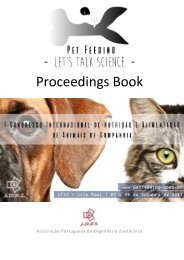Book of Proceedings I PetFeeding
Book of Proceedings I PetFeeding
Book of Proceedings I PetFeeding
Create successful ePaper yourself
Turn your PDF publications into a flip-book with our unique Google optimized e-Paper software.
45<br />
Feeding and nutrition <strong>of</strong> the dog: from young adult to geriatric<br />
Cecilia Villaverde<br />
Expert Pet Nutrition, Fermoy, Co. Cork, Ireland<br />
Introduction<br />
Feeding healthy dogs requires the provision <strong>of</strong> a diet that is specific (for dogs), adequate<br />
(complete and balanced), safe (free <strong>of</strong> contaminants, toxins, and pathogens), and palatable.<br />
This diet must be fed in sufficient amounts to maintain a stable body weight (BW) and an<br />
ideal body condition score (BCS).<br />
Energy requirements<br />
There are a variety <strong>of</strong> formulas that provide the energy requirements <strong>of</strong> adult dogs, see NRC<br />
(2006). FEDIAF (2017) and Gross et al. (2010), depending on the lifestyle, age, and breed <strong>of</strong><br />
the dogs. These formulas are all empirical and based on metabolic BW (kg 0.75 ) and they have<br />
an associated error that can be very high. These equations are for daily energy requirements,<br />
thus including basal metabolic rate, thermogenesis, thermic effect <strong>of</strong> food, and physical<br />
activity.<br />
Effect <strong>of</strong> breed<br />
Some breeds are prone to obesity, which suggests that there might be differences in either<br />
their drive to eat (which has been shown in Labrador Retrievers by Raffan et al., 2016) or<br />
their energy requirements.<br />
Effect <strong>of</strong> neutering<br />
Neutering is clearly a risk factor for obesity (Larsen and Villaverde, 2016. It has been<br />
suggested that sterilization results in an increased food and energy intake (Jeusette et al.,<br />
2004), but there is no clear described effect on basal metabolic rate. Neutering seems to have<br />
an effect on voluntary physical activity (Schauf et al., 2016), which could be the drive for the<br />
lower energy needs described in castrated dogs (Bermingham et al., 2014; Thes et al., 2016).<br />
Effect <strong>of</strong> activity<br />
In the above mentioned meta-analysis, Bermingham et al. (2014) found that racing dogs had<br />
higher energy requirements than pet and kennel dogs, with working and hunting dogs falling<br />
in the middle.<br />
Effect <strong>of</strong> age<br />
Even though some studies have found that older dogs have lower energy requirements than<br />
young adults (Thes et al., 2016), the Bermingham et al. (2014) did not identify this finding,<br />
but likely due to the small sample size. Obesity is more common in middle aged dogs vs<br />
young adults, which supports the theory that older dogs have lower energy needs, likely



